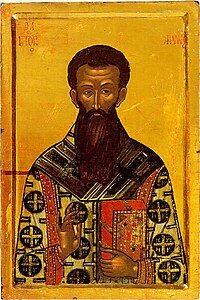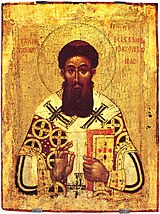Our website is made possible by displaying online advertisements to our visitors.
Please consider supporting us by disabling your ad blocker.
Hesychast controversy

| Part of a series on |
| Palamism |
|---|
 |
|
|
The Hesychast controversy was a theological dispute in the Byzantine Empire during the 14th century between supporters and opponents of Gregory Palamas. While not a primary driver of the Byzantine Civil War of 1341, it influenced and was influenced by the political forces in play during that war. The dispute concluded with the victory of the Palamists and the inclusion of Palamite doctrine as part of the dogma of the Eastern Orthodox Church as well as the canonization of Palamas.
About the year 1337, Hesychasm attracted the attention of a learned member of the Orthodox Church, Barlaam, a Calabrian monk who had come to Constantinople some seven years earlier. Reacting to criticisms of his theological writings that Gregory Palamas, an Athonite monk and exponent of hesychasm, had courteously communicated to him, Barlaam encountered Hesychasts and heard descriptions of their practices. Trained in Western Scholastic theology, Barlaam was scandalized by the descriptions that he heard and wrote several treatises ridiculing the practices. Barlaam took exception to, as heretical and blasphemous, the doctrine entertained by the Hesychasts as to the nature of the uncreated light, identical to that light which had been manifested to Jesus' disciples at the Transfiguration on Mount Tabor, the experience of which was said to be the goal of Hesychast practice. His informants said that this light was not of the divine essence but was contemplated as another hypostasis. Barlaam held the concept to be polytheistic, inasmuch as it postulated two eternal beings, a visible (immanent) and an invisible (transcendent) God. He accused Hesychasm to be a variant of Bogomilism.[1][2]
Gregory Palamas, afterwards Archbishop of Thessalonica, was asked by his fellow monks on Mt Athos to defend Hesychasm from Barlaam's attacks. Well-educated in Greek philosophy (dialectical method) and thus able to defend Hesychasm with methods in use also in the West, Palamas defended Hesychasm in the 1340s at a series of synods in Constantinople, and wrote a number of works in its defense.
In 1341, the dispute came before a synod held at Constantinople, which, taking into account the regard in which the writings of the pseudo-Dionysius were held, condemned Barlaam, who recanted and almost immediately returned to Calabria, afterwards becoming bishop of a Byzantine Rite diocese in communion with the Pope. Five other synods on the subject were held, at the third of which the opponents of Palamas gained a brief victory. However, in 1351, at a synod under the presidency of Emperor John VI Kantakouzenos, Palamas' real Essence-Energies distinction was established as the doctrine of the Orthodox Church.
Gregory Akindynos, who had been a disciple of Gregory and had tried to mediate between him and Barlaam, became critical of Palamas after Barlaam's departure in 1341. Another opponent of Palamism was Manuel Kalekas who sought to reconcile the Eastern and Western Churches. After the decision of 1351, there was strong repression against anti-Palamist thinkers. Kalekas reports on the repression as late as 1397, and for theologians in disagreement with Palamas, there was ultimately no choice but to emigrate and convert to union with the Latin Church, a path taken by Kalekas as well as Demetrios Kydones and John Kyparissiotes.
- ^ Russell, Norman (2019). "1. The Orthodox struggle to assimilate Palamite thinking". Gregory Palamas and the making of Palamism in the Modern Age. Oxford University Press. doi:10.1093/oso/9780199644643.003.0001.
- ^ Meyendorff, John (1988). "Mount Athos in the Fourteenth Century: Spiritual and Intellectual Legacy". Dumbarton Oaks Papers. 42: 157–65. doi:10.2307/1291594 – via JSTOR.
Previous Page Next Page


